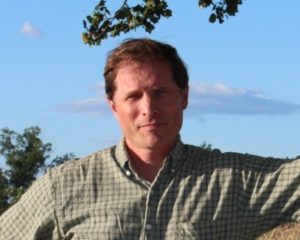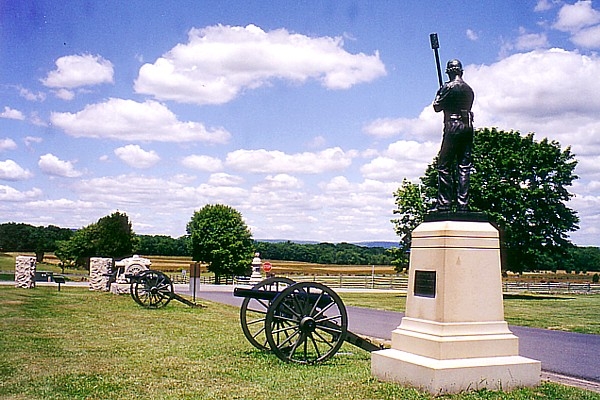Scott Hartwig is a popular historian for BGES, and while he has spent his career at Gettysburg working for the National Park Service, his interest and scholarship is at Antietam. He has been working on the definitive campaign study in two volumes for the 1862 Maryland Campaign. Volume One was published by Johns Hopkins Press a few years ago, and he has just finished Volume Two. BGES Blogger Jane Martin recently caught up with him to learn more about his forthcoming book, as well as his work at Gettysburg.

JM: What drew you to Antietam even though you worked at Gettysburg for your career?
SH: When I first became interested in writing about Antietam, there were only two book length studies: Jim Murfin’s Gleam of Bayonets and Francis Palfrey’s The Antietam and Fredericksburg. Compared to Gettysburg, Antietam was unexplored territory. I can also assure you, I never imagined how much work it would be to dig deeply into a subject as big as the 1862 Maryland Campaign.
JM: What’s it like working at Gettysburg?
SH: Let me first say, I loved my job and my career with the National Park Service. We live in a world today where public servants are not held in high esteem. I was proud to work for the public and had the privilege to work beside outstanding people—some of whom are still working in the NPS. They, we, worked hard, not for financial profit, but for something bigger than ourselves.
One of the things that made my job enjoyable was its variety. Yes, I had plenty of mundane work to do, there always is. But there was constantly something exciting going on to offset it. I think we made great strides in developing an interpretive program that reached a broad spectrum of people with varied interests. One of the most worn-out things I heard repeatedly was that places like Gettysburg only appeal to was older white guys. People who utter this mantra are never on the ground to see what is happening every day. We also made tremendous strides in educational programming and today, Gettysburg National Military Park is a model of how to do this right. One of our high points was a live satellite broadcast, before this sort of thing was routine. It reached millions of students across the country. We had always wanted to take Gettysburg to people who couldn’t get here, and I think we were very successful in doing this. Finally, I am very proud of the work we all did in creating the new museum, films, and cyclorama program, as well as the efforts to rehabilitate the historic landscape of the battlefield.

JM: Do you have any Special Stories?
SH: Quite a few, but I will only share a few. I gave a couple tours to now-deceased U.S. Senator Steven Symms of Idaho. On the second tour we were driving south on Carlisle Street into Gettysburg and came to a stop at the light near the Gettysburg College campus. There was an older fellow who used to ride around Gettysburg on his bike with a rabbit in is bike basket. While we were sitting at the light the rabbit jumped out and began running around in the road. Senator Symms and his friend both jumped out of the car and began chasing the rabbit around and helped to catch it. It was hilarious and a reminder that no matter what our station in life, we are all ultimately just ordinary people.
One November 19 in the late ’90s, General Colin Powell was the speaker for our Dedication Day ceremonies. Before the ceremony, there is always a wreath-laying at the Soldiers National Monument and I was assigned to “assist” the general with placing the wreath. This was by request from his office at the Joint Chiefs of Staff. Powell is a tall man, and I instantly felt when I met him, that he was a real, genuine person. While standing waiting for the ceremony to begin he leaned over to me and asked, “How exactly are you going to assist me?” I looked at him and said, “I have no idea.” He smiled, winked, and said, “I got this.”
In 1980, I was assigned to spend two days on the battlefield with General Don Starry and the British Quartermaster General Wolsley, who was a World War II veteran. Starry was the commander of 5th Corps in Germany, and a Korea and Vietnam veteran. I learned far more from these two gentlemen over the two days than I ever imparted to them about the battle of Gettysburg. It was an unforgettable experience.
JM: Would you do it over again?
SH: Absolutely! The shame of it is the that due to incessant budget cuts and general agency dysfunction, just getting into the NPS today is challenging and following the path I did, would be almost impossible.
JM: How do you enable people to “be there in the room where it happened?”
SH: History needs to be relevant for people to find it of interest or value. My goal as an interpreter or leading a tour was to always seek to establish the relevancy of what we were talking about to people’s lives. Having facts and figures is important for a historian or interpreter, but relying on them to try to carry a program will cause people’s eyes to glaze over. We learn best from the experiences of other people. I always seek to humanize history. It is also important for people to be active learners, rather than passively standing and listening. Get them into the landscape, make them think critically, and ask questions.
JM: What’s next, Scott?
SH: Johns Hopkins hopes to publish my Volume Two, which I have tentatively titled I Dread the Thought of the Place: The Battle of Antietam and its Aftermath, in the spring of 2022. I have just finished the chapters covering the military operations of the battle and end of the campaign and have two chapters left to write about the aftermath and consequences of the battle and campaign.
JM: Thanks so much, Scott!
You must be logged in to post a comment.